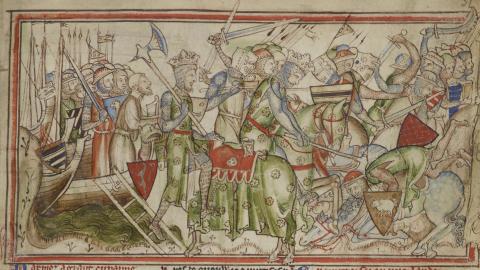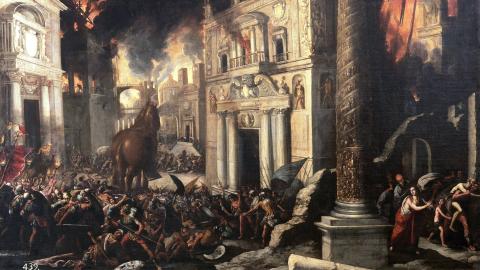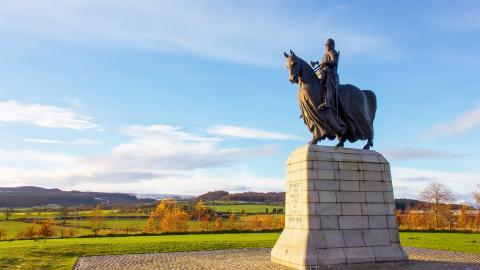River Forth and the Battle of Stirling Bridge (Season 1)
Beau Ouimette doesn’t just have a cool name – he’s made metal detecting a spectator sport, gaining millions of YouTube views as he goes looking for treasure in the watery parts of the US. Now, in River Hunters, he’s teaming up with our own Rick Edwards to seek out hidden historical gems in British waterways. It’s the first time many of these rivers have been explored in this way, and our intrepid duo will be delving into key historical events like the Wars of the Roses and the English Civil War along the way.
The mighty River Forth is one of the most fascinating stops for Rick and Beau, because it plunges the pair into tales of William Wallace, Robert the Bruce and the Scottish Wars of Independence. It was on the shores of the river that one of the most famous military confrontations in Scottish history took place: the fabled Battle of Stirling Bridge, memorably depicted with a distinct lack of bridge in Mel Gibson’s Braveheart. It’s here that, so many centuries after William Wallace’s victory over the forces of England’s Edward I, Beau and Rick hope to excavate traces of this brutal skirmish, from spearheads to sword blades.
The battle was the result of years of tension and outright bloodshed which stemmed from a succession crisis north of the border. Years before, in 1286, Scotland’s Alexander III died after falling from his horse. His heir – Margaret, Maid of Norway – then died while on her way to take her place on the throne. Her premature passing set Scotland on the path to war, as England’s Edward I installed a puppet ruler – John Balliol – and started treating Scotland as a kind of colony of England.
Many Scots were understandably miffed at this turn of events, and guerrilla rebellions eventually flared up. Among the warriors to emerge from the wilds of Scotland were William Wallace and Andrew de Moray, who separately struck against English representatives before teaming up for a major standoff at Stirling Bridge.
The Scottish were the underdogs here...
This was a key strategic location because the bridge over the Forth was a major gateway to Scotland. Assembled on the southern banks of the river were Edward’s knights, sent to crush the Scottish rebellion. They were under the command of John de Warenne, the 6th Earl of Surrey, and Hugh de Cressingham, whose role as the king’s tax collector in Scotland made him every bit as despised as you might imagine. Meanwhile, on the northern side of the river, Wallace and de Moray lay in wait with their motley army largely made up of Scottish commoners, farmers and labourers, surveying the landscape from a hill now known as Abbey Craig.
The Scottish were the underdogs here, outnumbered by the wide array of foot soldiers and mounted knights on the English side. (Though ‘English’ here isn’t quite accurate, as Edward’s forces also included hundreds of Welsh soldiers, happy to earn a crust by working for the king.)
But, what Wallace and de Moray DID have on their side was tactical brilliance and the geography of the area. The presence of the narrow, wooden bridge meant Edward’s men would find themselves in a bottleneck as they crossed the Forth. This caused alarm for a Scottish knight who’d switched allegiance to Edward. He warned de Warenne and de Cressingham, 'If we go onto the bridge we are dead men', and instead argued the troops should cross the river further upstream, where more men could cross at any one time.
The king’s forces who’d crossed the bridge were effectively trapped
De Cressingham was impatient and pushed to cross at Stirling Bridge itself, believing the Scots would generously sit back and wait for the movement of men to the north banks to be complete before engaging in battle. This was a catastrophic miscalculation. As one chronicler, Walter of Guisborough, would later put it: 'It was astonishing to say, and terrible in its consequence, that such a large number of individual men, though they knew the enemy was at hand, should go up to a narrow bridge which a pair of horsemen could scarcely and with difficulty cross at the same time'.
Wallace and de Moray waited till just enough enemy troops had crossed (a large enough number to sustain mass casualties, but not so large that they’d outnumber the Scots) and launched their attack. The king’s forces who’d crossed the bridge were effectively trapped between the on-coming Scots on one side and the river on the other.
What followed was, effectively, a massacre, with spears and longswords cutting down the hapless English and Welsh soldiers. Even the king’s formidable cavalry was rendered ineffective by the marshy ground and noose-like loop of the Forth. One of those slaughtered was Hugh de Cressingham himself, whose skin was allegedly cured and turned into a pelt for Wallace’s sword. The Scots also lost a key figure – Andrew de Moray, who would succumb to injuries from the battle.
It was a major victory for the Scottish and a cornerstone of the Wallace legend. However, William Wallace’s reputation as a military genius would later be dealt a death blow by his defeat at the Battle of Falkirk, and it would be another iconic patriot – Robert the Bruce – who’d score a more significant victory against the English at the Battle of Bannockburn in 1314.
Could the landscape around the modern Stirling Bridge still hold relics from those dramatic days in Scottish history? Beau and Rick will be using the latest technology to find out – and hopefully gain new insights into a fabled chapter of Britain’s past.















